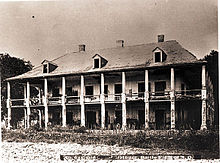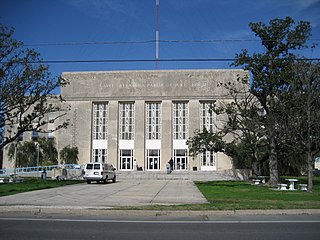
St. Bernard Parish is a parish in the U.S. state of Louisiana. The parish seat and largest community is Chalmette. The parish was formed in 1807. St. Bernard Parish is part of the New Orleans–Metairie metropolitan statistical area; the parish is located southeast of the city of New Orleans and comprises the Chandeleur Islands and Chandeleur Sound in the east.
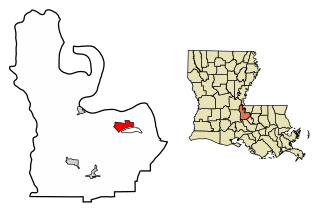
New Roads is a small town in Pointe Coupee Parish, Louisiana, United States. The center of population of Louisiana was located in New Roads in 2000. The population was 4,831 at the 2010 census, down from 4,966 in 2000. In the 2020 census the population was 4,549, while at the beginning year of 2023 the census showed a population of 4,205 and expects to be under 4,000 by the years end. The city's ZIP code is 70760. It is part of the Baton Rouge Metropolitan Statistical Area.

Chalmette is a census-designated place (CDP) in, and the parish seat of, St. Bernard Parish in southeastern Louisiana, United States. The 2010 census reported that Chalmette had 16,751 people; 2011 population was listed as 17,119; however, the pre-Katrina population was 32,069 at the 2000 census. At the 2020 U.S. census, its population rebounded to 21,562. Chalmette is part of the New Orleans–Metairie–Kenner metropolitan statistical area. Chalmette is located east of downtown New Orleans and south of Arabi, towards Lake Borgne.

The Battle of New Orleans was fought on January 8, 1815 between the British Army under Major General Sir Edward Pakenham and the United States Army under Brevet Major General Andrew Jackson, roughly 5 miles (8 km) southeast of the French Quarter of New Orleans, in the current suburb of Chalmette, Louisiana.

Major General Sir Edward Michael Pakenham,, was a British Army officer and politician. He was the son of the Baron Longford and the brother-in-law of the Duke of Wellington, with whom he served in the Peninsular War. During the War of 1812, he was commander of British forces in North America (1814–15). On 8 January 1815, Pakenham was killed in action while leading his men at the Battle of New Orleans.
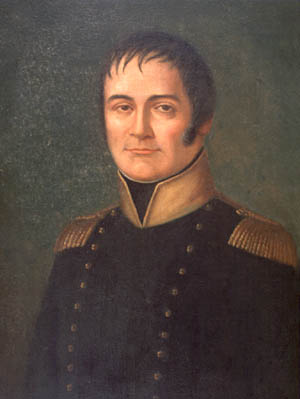
Jacques Philippe Villeré was the second Governor of Louisiana after it became a state. He was the first Creole and the first native of Louisiana to hold that office.

Joseph Marshall Walker was a Louisiana soldier and politician and the 13th Governor of Louisiana, from 1850 to 1853. He is best known for being the first Governor inaugurated in the new state capital building in Baton Rouge.
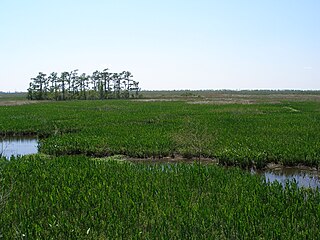
Jean Lafitte National Historical Park and Preserve protects the natural and cultural resources of Louisiana's Mississippi River Delta region. It is named after French pirate Jean Lafitte and consists of six separate sites and a park headquarters.
Bayou Bienvenue is a 12.1-mile-long (19.5 km) bayou and "ghost swamp" in southeastern Louisiana. It runs along the political border between Orleans Parish and St. Bernard Parish to the east of New Orleans. The Bayou Bienvenue Wetlands Triangle viewing platform in the Lower Ninth Ward provides expansive views of the bayou and also serves as an educational resource about restoration efforts in the area.

Chalmette National Cemetery is a United States National Cemetery located within Jean Lafitte National Historical Park and Preserve in Chalmette, Louisiana. The cemetery is a 17.5-acre (7.1 ha) graveyard adjacent to the site that was once the battleground of the Battle of New Orleans, which took place at the end of the War of 1812. Despite its proximity to the site of the Battle of New Orleans in the War of 1812, the majority of the interments are of soldiers who were casualties or veterans of the American Civil War, the Spanish-American War, World War I, World War II, the Korean War, or the Vietnam War. The cemetery was subsequently closed to new interments.

Jean-Noël Destréhan de Tours was a Creole politician in Louisiana and one-time owner of St. Charles Parish's Destrehan Plantation, one of Louisiana's historic antebellum landmarks. The community of Destrehan was named for his family.
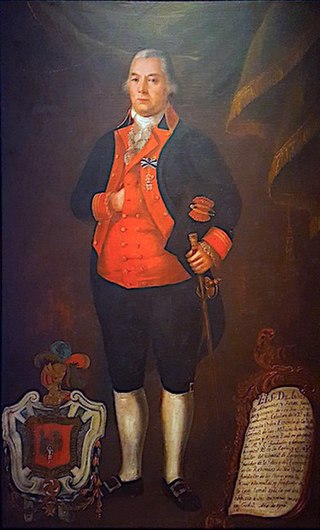
DonAndrés Almonaster y Roxas de Estrada was a Spanish civil servant and philanthropist of New Orleans, today chiefly remembered for his numerous charitable benefactions made to the city of New Orleans.
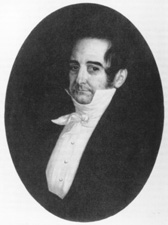
Charles Dominique Joseph Bouligny was a lawyer and politician, elected as U.S. Senator from Louisiana, serving from 1824 to 1829. He had earlier served in the territorial House of Representatives. Of French and Spanish descent, he was brother to Louis Bouligny, a state representative, and uncle of John Edward Bouligny, who was elected as U.S. Representative from New Orleans.
Caernarvon is an unincorporated community in St. Bernard Parish, Louisiana, United States. The name of the community is from a plantation originally located here. The plantation's name is widely believed to be from a similarly named town and castle in Wales. Names of antebellum plantations in the American South were often reflective of European roots and aspirations of grandeur; two upriver Mississippi River plantations, Nottoway near White Castle, Louisiana, and Sans Souci near Osceola, Arkansas, are two examples of this tradition.

Micaela Leonarda Antonia de Almonester Rojas y de la Ronde, Baroness de Pontalba was a wealthy New Orleans-born Creole aristocrat, businesswoman, and real estate designer and developer, who endures as one of the most recalled and dynamic personalities in the city's history, though she lived most of her life in Paris.
René-Louis Chartier de Lotbinière (1641–1709) was a French-Canadian Poet, 1st Seigneur de Lotbinière in New France (1672), Judge of the Provost and Admiralty Courts and Chief Councillor of the Sovereign Council of New France.

Ignace François Broutin was a French Chevalier of the Order of St. Louis military officer, commander of Fort Rosalie among the Natchez people, and later an architect and Captain of Engineers of the King in the Province in colonial Louisiana. He is chiefly remembered for designing the Ursuline Convent, completed by 1753 and the oldest and only surviving French colonial building in New Orleans.
George A. Hero was a New Orleans entrepreneur who organized the drainage of vast tracts of swampland on the West Bank of the Mississippi River at New Orleans. He was known locally as the "Drainage King". and was founder of the Hero Land Company. Later Hero was involved in a project to build a bridge from New Orleans to the West Bank, but this was never completed.
Jean-Baptiste d'Estrehan de Beaupré was a high-ranking French official in colonial Louisiana and the founder of the Destrehan family there. A native of France, he was appointed Royal Treasurer of Louisiana early in the colony's history. He arrived in New Orleans in 1722, the year it was designated as the capital of Louisiana.
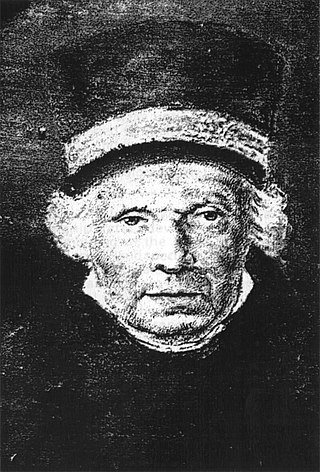
Charles Frederic d'Arensbourg (1693–1777), born Karl Friedrich von Arensburg, was an early leader in the settlement of the German Coast region of Louisiana.

